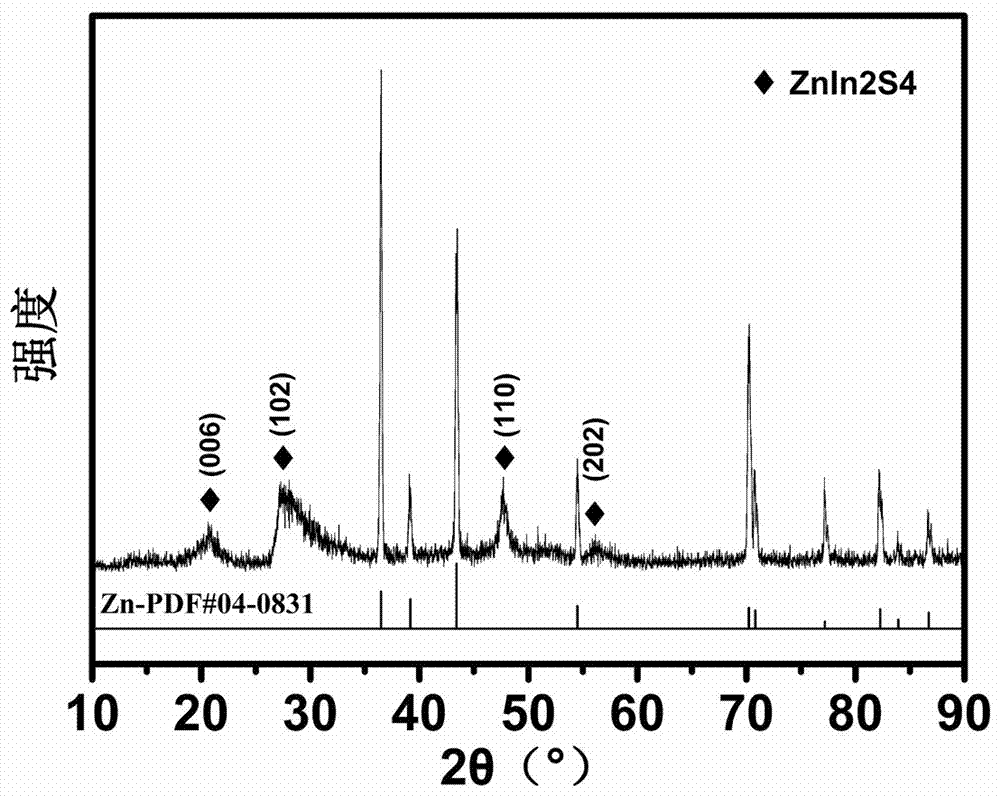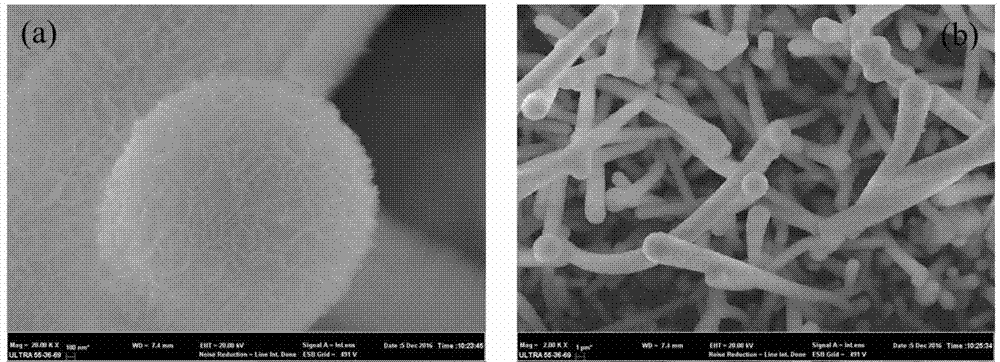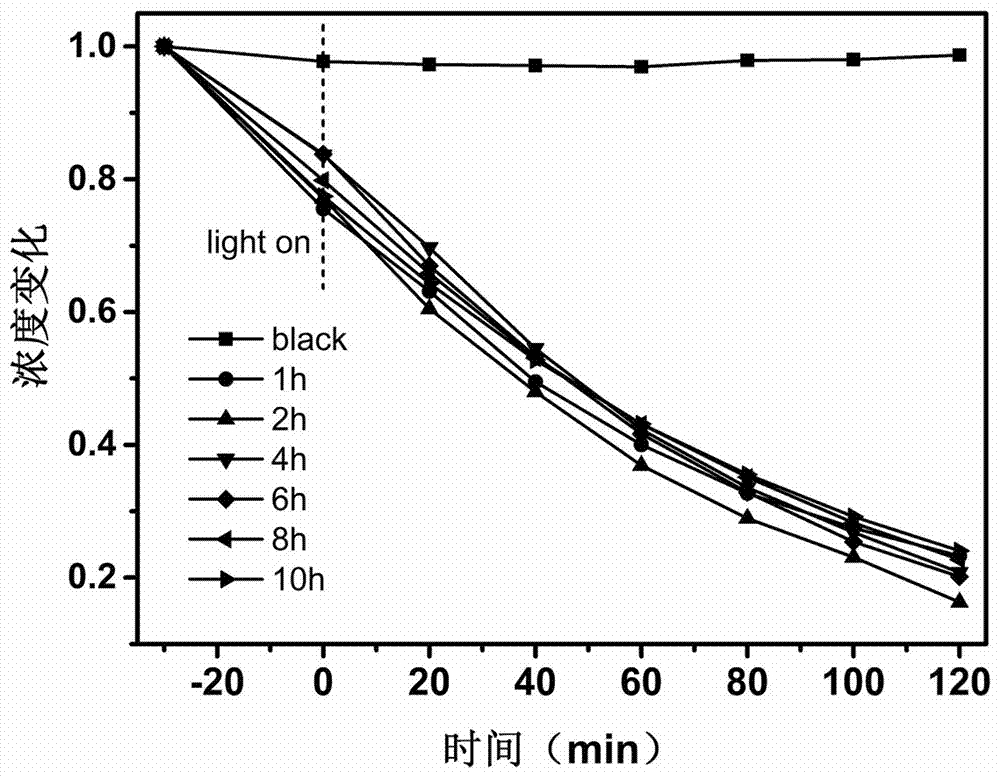Three-dimensional flower-sheet-shaped sulfur-indium-zinc micro-nanowire array as well as preparation method and application thereof
A nanowire array, sulfur indium zinc technology, applied in the direction of nanotechnology, nanotechnology, chemical instruments and methods, etc., can solve the problems of complex process, high cost, difficult recycling, etc., and achieve simple preparation process, easy recycling, and low cost Effect
- Summary
- Abstract
- Description
- Claims
- Application Information
AI Technical Summary
Problems solved by technology
Method used
Image
Examples
Embodiment 1
[0032] A three-dimensional flake-like sulfur indium zinc (ZnIn 2 S 4 ) A method for preparing a micro-nanowire array, comprising the following steps:
[0033] (1) First polish the cut zinc sheet with 3000 mesh sandpaper to remove the oxide layer on the surface;
[0034] (2) Wash the zinc flakes polished in (1) with acetone, absolute ethanol, and deionized water for 10 minutes in sequence, then dry them with an air gun, and then put them into the inner tank of the reactor as a base;
[0035] (3) Mix thioacetamide and indium chloride into the reaction kettle according to the molar ratio of 2:1, then add ethylene glycol, and then stir or ultrasonically dissolve to form a uniform solution with an indium salt concentration of 0.4M ;
[0036] (4) Seal the reactor, control the temperature at 200°C, and react for 2 hours; after the reaction, the reactor is naturally cooled to room temperature, and the sample is taken out and washed and dried to obtain a three-dimensional flake-like Z...
Embodiment 2
[0040] A three-dimensional flake-like ZnIn 2 S 4 A method for preparing a micro-nano wire array, comprising the following steps:
[0041] (1) First polish the cut zinc sheet with 3000 mesh sandpaper to remove the oxide layer on the surface;
[0042] (2) Wash the zinc flakes polished in (1) with acetone, absolute ethanol, and deionized water for 10 minutes in sequence, then dry them with an air gun, and then put them into the inner tank of the reactor as a base;
[0043] (3) Mix thiourea and indium sulfate into the reaction kettle according to the molar ratio of 4:1, then add ethylene glycol, and then stir or ultrasonically dissolve to form a uniform solution with an indium salt concentration of 0.2M;
[0044] (4) Seal the reactor, control the temperature at 160°C, and react for 10 hours; after the reaction, the reactor is naturally cooled to room temperature, and the sample is taken out and washed and dried to obtain a three-dimensional flake-like ZnIn that grows uniformly o...
Embodiment 3
[0046] A three-dimensional flake-like ZnIn 2 S 4 A method for preparing a micro-nano wire array, comprising the following steps:
[0047] (1) First polish the cut zinc sheet with 3000 mesh sandpaper to remove the oxide layer on the surface;
[0048] (2) Wash the zinc flakes polished in (1) with acetone, absolute ethanol, and deionized water for 10 minutes in sequence, then dry them with an air gun, and then put them into the inner tank of the reactor as a base;
[0049] (3) Cysteine and indium acetate are mixed and added to the reaction kettle according to the molar ratio of 6:1, then ethylene glycol is added, and then stirred or ultrasonically dissolved to form a uniform solution with an indium salt concentration of 0.4M;
[0050] (4) Seal the reactor, control the temperature at 180°C, and react for 6 hours; after the reaction, the reactor is naturally cooled to room temperature, and the sample is taken out and washed and dried to obtain a three-dimensional flake-like ZnI...
PUM
 Login to View More
Login to View More Abstract
Description
Claims
Application Information
 Login to View More
Login to View More - R&D
- Intellectual Property
- Life Sciences
- Materials
- Tech Scout
- Unparalleled Data Quality
- Higher Quality Content
- 60% Fewer Hallucinations
Browse by: Latest US Patents, China's latest patents, Technical Efficacy Thesaurus, Application Domain, Technology Topic, Popular Technical Reports.
© 2025 PatSnap. All rights reserved.Legal|Privacy policy|Modern Slavery Act Transparency Statement|Sitemap|About US| Contact US: help@patsnap.com



